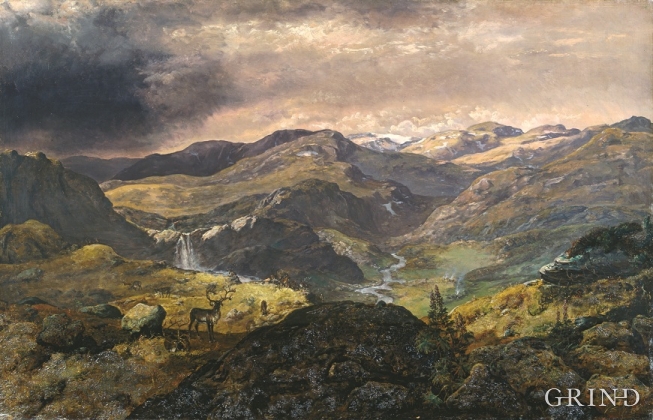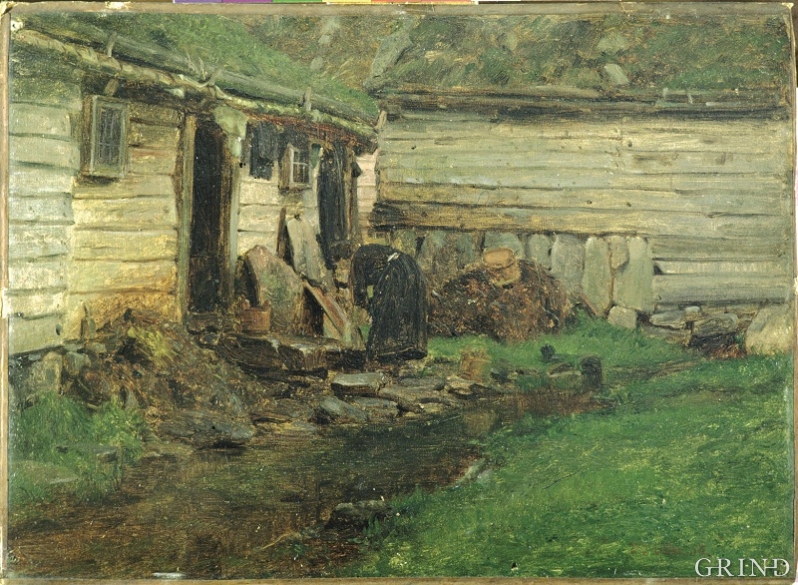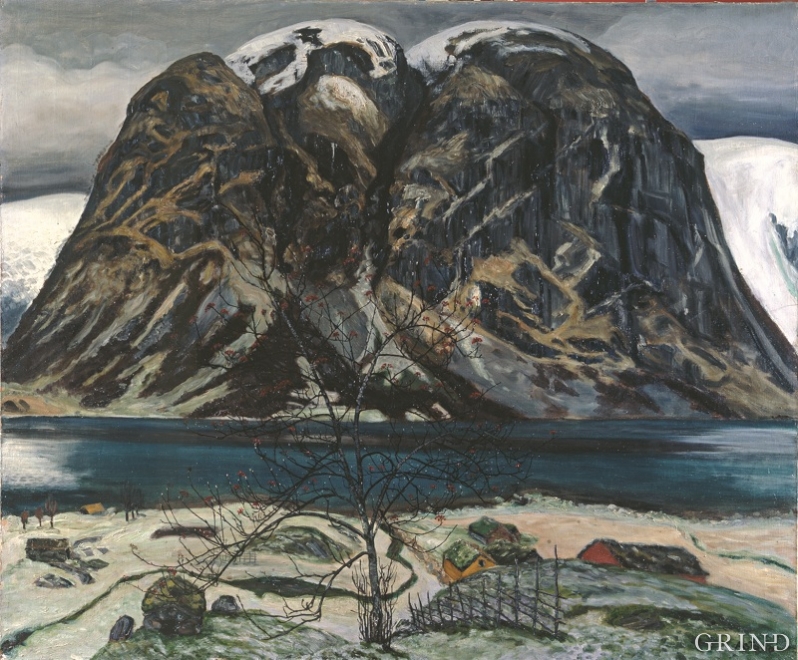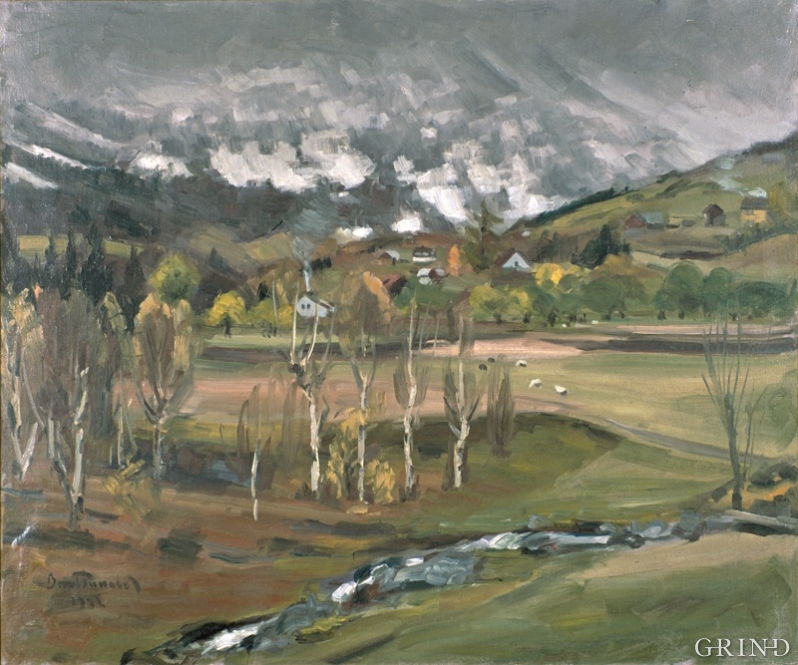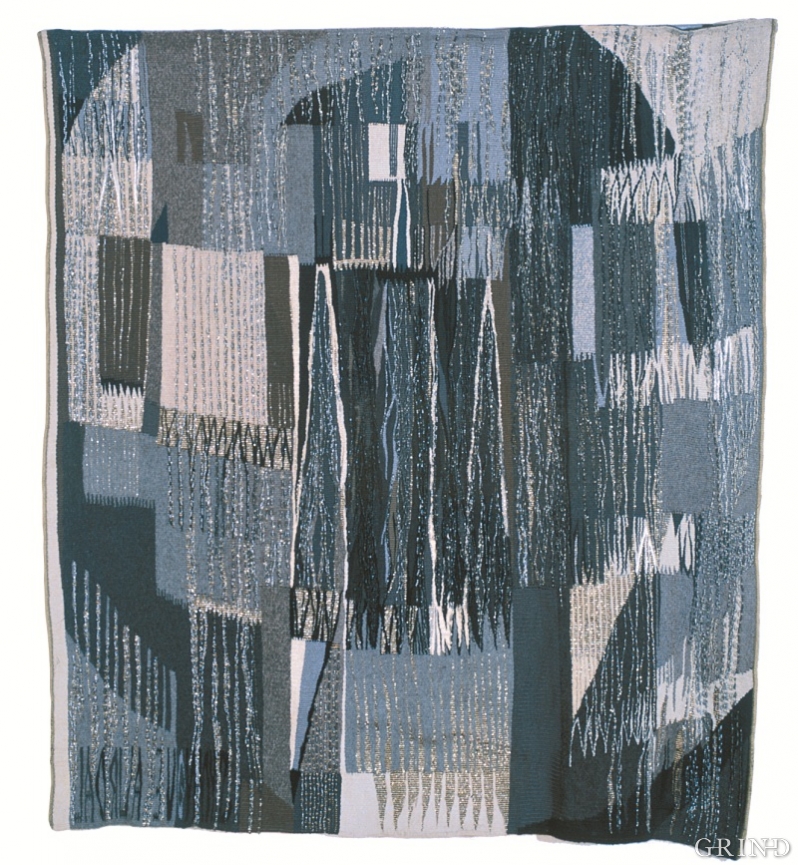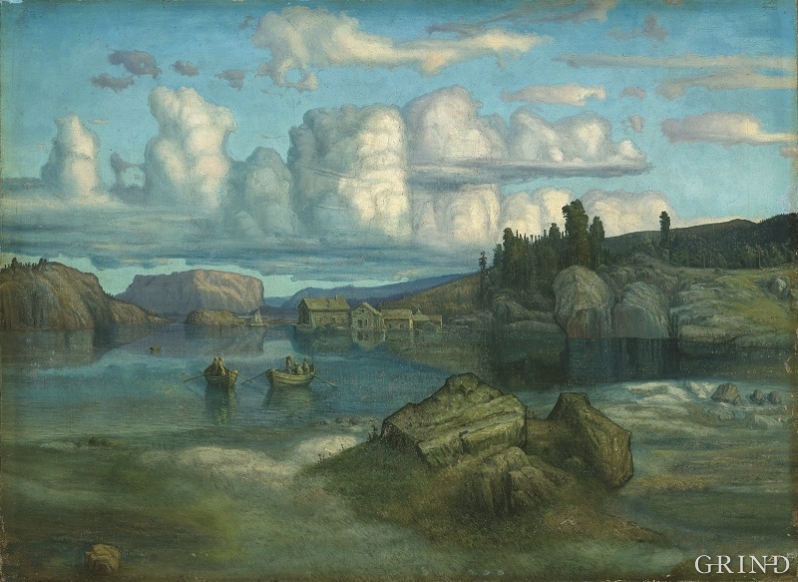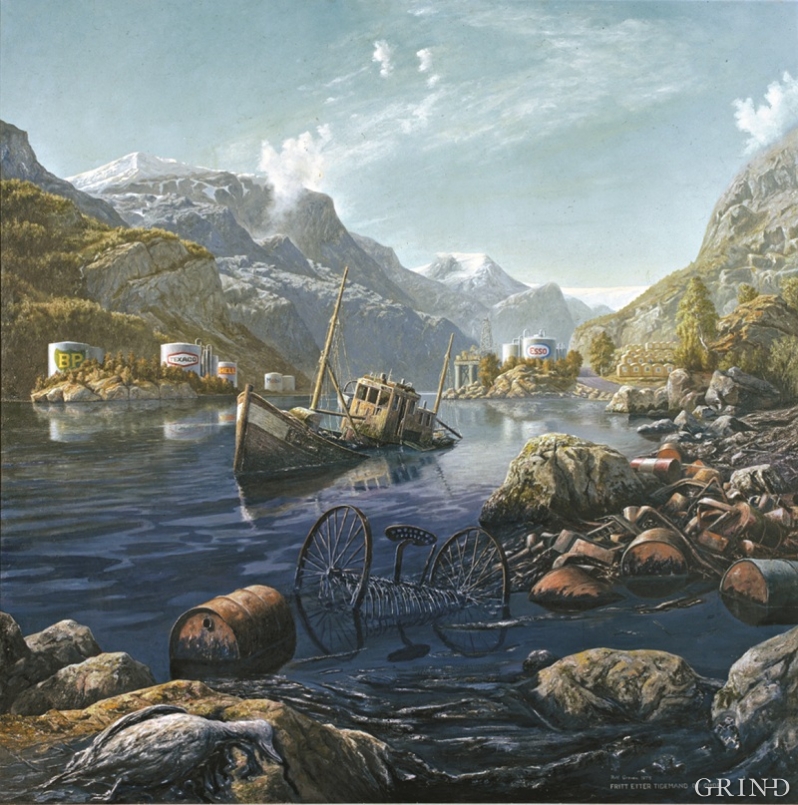Published: 19.05.2009 | Author: Gunnar Danbolt
J.C. Dahl: "Måbødalen", 1854 (Owner: Rasmus Meyers Samlinger, Bergen Kunstmuseum. Photo: Fotograf Henriksen a.s./Geir S. Johannessen).
”A day that passed us as a stranger, later becomes a gift, and opens up as such.” Rainer Maria Rilke
As we travel westwards across the Hardanger plateau and having passed the watershed, the brown interminable moorland changes into an amazing panorama over a wild and serrated mountain landscape, with horizon beyond horizon, until the mountains at the edge of the horizon are swallowed up by the airy atmosphere. This sight not only moves the hearts of Norwegians born on the west side of the mountains, but Norwegians, Swedes, Germans and Americans alike, are all equally captivated. This is the West at its most dramatic.
One would think that such an experience of Nature is a general experience of all human beings. Not being impressed by such a panorama would require a heart of stone. But – if we go back 200 years in time – to around 1800 – the majority of our “cultured” compatriots would only have felt a dark shudder of something desolate and forlorn when they saw mountains and fjords, highlands and water falls. Ludvig Holberg (1684-1754), who in other connections had plenty of praise for Bergen, was not very taken by the seven mountains, and the bishop Claus Pavels (1769-1822) noted in his diary after a visitation to Lofthus in Hardanger around 1820, that ‘I have during this journey seen little of Nature’s beauty – the landscape is raw and uncultivated.’ Such pronouncements are in fact representative for the time before 1800. There was not a total rejection of all Nature, as in the Middle Ages, only those parts that were not cultivated or ‘tamed’ by Man. Only the cultivated landscape was regarded as beautiful. Italy was a country rich in such cultivated landscapes, but Norway was not. It is therefore not surprising that Norway was regarded as barren and raw, with a nature bereft of aesthetic qualities. We therefore have to ask – who taught us to appreciate “our mountainous Norway?” And when did this come about?
From raw nature to sublime landscape
It was at the end of the 1700s that a new concept of Nature and landscape started to emerge. This did not happen in Norway, but in England and France. An intellectual elite started regarding what human beings had created themselves, i.e. culture, as a prison that constrained human spontaneous feelings and experiences and forced the landscape into strict shackles. Thus the beautiful landscape, the parklands, came into discredit and was replaced by the sublime landscape, the kind of landscape that revealed the magnitude of Nature. The interminable ocean and the precipitous mountains were sublime, because the grandeur and power of Nature were so clearly expressed through them.
It is therefore not by chance that at the beginning of the 1800s Norway became a favoured destination – for painters. The west of Norway could provide the pleasant thrill they sought. The concept of sublime gave a value to Hordaland, and made a painter like Johan Christian Dahl (1788-1857) paint high western mountains and fjords. It was his paintings, more than anything else that opened people’s eyes to the fact that precipitous mountains and deserted plateaus had their own fascination. It is therefore not an exaggeration to say that it was the Norwegian painters who taught us to see, experience and appreciate Norwegian Nature.
Landscape and temperament
J.C.Dahl regarded Nature as a living organism, in which landscape, climate and natural resources formed a framework and laid the basis for Man’s work. This was because it was Man’s work that created culture and history, and because landscape, climate and natural resources change, it is not just a question of one culture, as was the idea in the 1500 – 1600s, but of several cultures, one for every nation. The word of national culture was made a code, together with the concept of Volksgeist, or natural character. This insight at the end of 18th century became important for J.C.Dahl because it demonstrated for him how a Norwegian landscape had to be constructed in order to show the Norwegian people’s spirit.
If we look at his magnificent painting “Måbødalen” (1854), we become aware that it is the great view and the faraway perspective that preoccupy Dahl. He follows the tradition by dividing it into a dark foreground, a highlighted middle ground and a more diffuse background. This was a division of elements designed to make it easier to enter into the painting. But in Dahl’s painting they assume an ulterior meaning. In the foreground he carefully describes the characteristics of West Norway’s plants, trees and animals. He elaborates on the sketches he had previously made on his many travels in Norway – picture-perfect fresh, and extremely well observed features of Norwegian flora and fauna; so carefully recorded that on the basis of them modern botanists are able to describe the spread of certain plant diseases. In the middle distance he conjures up the sublime Norwegian mountain landscape - overwhelming in its grandiose wildness, with wind-weathered trees and precipitous water falls. The middle ground often contains, though not in this painting, features of Norwegian culture, people and building styles, carefully recorded. Even so, the background is probably the most important element, with heavy clouds and small glimpses of blue sky. The atmosphere of the landscape depends on these heavy watery clouds through which sunlight only partly is able to penetrate. And the lighting is accordingly, speckled and broken up. Brightly lit sections are followed by shaded ones. We perceive that in a moment the light has shifted or has disappeared completely.
This is how Dahl manages to insert a moment of instability and the mood of the here and now in his stable and massive mountain formations.
Dahl managed to transform the mountain into an object of reflection; a way into our own shifting, west Norwegian temperament. But he did more than that; he discovered the values in the west Norwegian landscape; the poetry in the heavy water-logged clouds that give to Nature – and his paintings – life and energy. In that sense he was our first climate poet, with an incisive view of the depth and character which the dramatic and changing light gives the various landscapes.
From the sublime to the idyllic
While Dahl chose the high viewpoints, the “Düsseldorfers” our foremost landscape romanticists, went down from the mountain tops and into the forests where they found small clearings, well protected by rocky outcrops, clusters of trees or hillsides. The wild mountain was visible at times, but usually at a safe distance, and more often than not enveloped in clouds or mist. Depth was added to this landscape by zones of light and shade that gave shape to some details and tucked others into whole or part shadow. A cluster of trees, gnarled boulders, houses or animals gave these paintings life and replaced the action.
A düsseldorfer from the west of Norway who emphasised the west Norwegian landscape was Anders Askevold (1834-1900). He shows us some of West Norway’s idyllic features; small, still lakes, clucking streams, peacefully grazing animals, surrounded by a distinctive, deep shade of green. A shade of green that compresses the entire west Norwegian landscape space, the fertility, the moisture and the colour. Askevold was more than a local artist; he is the painter of the green colour and the picturesque style of building. We can see both of these features in his painting “Gamle hus” (Old houses) from 1887. A yard between two old farm houses, where the ground is intensely moisture-green and where the houses, with their rough hewn planks and turfed roofs look as if they have emerged from the very ground. Though that is probably taking it too far – it is rather Nature transformed into culture – and then worn down and overgrown by that same Nature. It is hard to portray the picturesque in a better way.
This painter, who hailed from Sogn og Fjordane, but lived most of his life in Hordaland, has depicted unknown features of West Norway, features that did not interest his predecessor J.C.Dahl. Askevold did not preoccupy himself with the wild and the heroic, but concentrated on the small and idyllic, the poetry in the small and non-dramatic things.
One of the most poetic – and to many – one of the most beautiful landscape paintings within Norwegian art is Adolph Tidemand's (1814-1876) and Hans Gude (1825-1903) fjord idyll from Sørfjorden “Brudeferden i Hardanger” (the wedding party on the Hardanger fjord). However, in this romantic landscape portrait there is not a deeper sense of acknowledgement.
Landscape and acknowledgement
Should we experience Sørfjorden and the approach to Utne on a sunny summer’s day, we may feel removed to the Rhine Valley in Germany. The fruit orchards on the hillsides are arranged as orderly as the German vineyards and give associations to more southern and warmer climes. But if we turn around and look across the fjord to the impressive mountain massif “Oksen” (“the Bull”) we are again back in Norway – back to the heathen and secretive Norway, which Nikolai Astrup (1880-1928) conjured up on his canvasses. Though to experience this the sun should preferably have set. It is in the summer nights that “Oksen” appears in its supernatural enormity; in these west Norwegian summer nights that are darker and more secretive than those in the east of Norway.
Twilight and night are times most heavy with feeling within the 24 hour cycle; the ones that most clearly reflect our inner feelings, if these things interest us. And Astrup was interested in these feelings. The nature he painted and was familiar with was not the only thing he wanted to convey; as well as the exterior landscape, he also wanted to depict the inner landscape. This he hinted at in his composition and method of painting, which in certain ways made a break with the realistic conventions. He did this because he wanted to capture the landscape heavy with feeling with the naïve eyes of a child, uncluttered by learning. It is the child who lives most directly in association with Nature – at least this was the general idea around the turn of the last century – and it is therefore the child that most easily finds the harmony between the moods of Nature and its own. Yes, they often glide unnoticeably into each other in a child’ mind.
“Look for motifs in the boys’ drawings”, Astrup noted in one of his “Notebooks”. He did not want to depict Nature as it appeared in front of him – and was therefore not a realist – but as he remembered them from “the boys’ drawings”, genuine and original.
How is this childlike and original expressed? First and foremost through a number of non-realistic features: a tendency towards axial and symmetrical compositions, to decorate the space and erase details, and to choose colours that often do not correspond to Nature’s own. The Kollen (Mound) paintings from Jølster illustrate this, and “Oksen”, axial and symmetrical as it is depicted, almost look as if it were shaped by Astrup himself.
Rain and misty skies may be beautiful
It has to be said that sunshine and warm, secretive nights are not the most well-known features of Hordaland. Often – far too often – we meet a West Norway enveloped in mist and rain, and it is a type of weather that puts us in more melancholy moods. But rain and mist may also have their values. That was demonstrated by the painter Bernt Tunold (1877-1946). Like Askevold before him, it was the poetic qualities in the west Norwegian landscape he sought to capture: the greenness and the landscape. He was probably the first one to paint rainy days, something J.C.Dahl never did. Thus grey and green in all their shades were the colours he mostly used. Nobody, apart from him, has managed to explore the many qualities of the colour green.
The painting that most clearly shows Tunold as a climate poet and rain-weather painter is “Mot Vinter” (The approach of winter) (1942); a depiction of an autumnal mountain landscape in which fog and heavy clouds almost entirely hide the great mountains in the background. We still see here and there the dark green, but now rapidly receding. The warm yellow and brown shades of autumn have now taken over and only left the green colour in some trees somewhere far into the landscape, and as pale patches on the ground. It is in paintings like these that Tunold manages to bring out the poetic qualities of apparently disconsolate autumn days with rain and fog. He is one who has made the west of Norway bearable for us and made us see that rain and mist also have qualities, moody and colourful, and made rainy days to more than mere parentheses in our west Norwegian reality.
Other painters have followed in his footsteps, for instance Ludvik Eikaas (1920 -). Even though Eikaas is an artist who plays on innumerable different strings, he has also picked up the inheritance from Tunold. In a painting called “Grå Dag” (Grey day) he has painted a west Norwegian farm, enveloped in a rain-heavy atmosphere and surrounded by rain-sodden fields. This is how we can experience Hordaland when the clouds close in on the mountains and transform the landscape into a dark outdoor room. But then a sharp shaft of light may dart over a house gable and create an illuminated, almost supernatural mood in this gloomy darkness. This is another aspect of west Norwegian nature – the light as an unexpected gift.
Rain in itself, as heavy illuminated stripes can also be beautiful. For the textile artist Synnøve Anker Aurdal (1908-) “Regnteppe” (Rain tapestry), the rainy, grey atmosphere itself has become the main subject. Against a surface of grey-black shades with a whole array of subtle contrasts, she has arranged metal lines with pearls. It is difficult to see how better and more explicitly one can depict the rain. The tapestry awakens something within us, it is as if tedious west Norwegian grey weather assumes a new dimension.
Thus, even when heavy clouds weigh down over the Hardanger fjord and create darkness at noon, there is still hope. Rain, mist and clouds have their own attraction that art has taught us to appreciate. And besides, it is the rain that has given us a green colour that even Ireland may envy us, and shades of grey that are far more diverse and interesting than we are aware when we are subject to the worst weather.
From smoke house to sea and skies
Along the twisty road from Kvanndal to Kvam we pass an old group of buildings; houses with grey and worn cladding, and large, heavy roofs of slate. If we take the time to knock on the door of one of the buildings, like the vicarage in Vikøy we may suddenly find ourselves in a painting by Adolph Tidemand. His arguably best known painting “Haugianerne” (The Haugians) (1847-48) is set inside a smoke house, just like this one. In order to emphasise that Hans Nilsen Hauge, who was an ordinary layman, nevertheless conveyed God’s grace and forgiveness, Tidemand lets a strong shaft of light shine on the preacher from a smoke vent in the roof. This gives the painting a sacral and almost mystical atmosphere, which does not diminish as we feel the rays of the sun outside. The sun becomes a symbol of God.
But – if we take the ferry out on the Hardanger fjord, towards the coast, we encounter another painter, Lars Hertevig (1830-1902). His summer paintings from Tysvær are not just representative of Ryfylke, but of large parts of Sunnhordland. The coast with its low-lying islands and summery light white clouds against a high dominating sky is an agreeable contrast to the mountain-scape of the land behind. Here is space and wide views, not predominantly towards steep mountain walls, but towards an ever changing sky. The clouds race past and assume the strangest forms. And then there’s the light, a blinding light that we notice all the more as we proceed out of the narrow Hardanger fjord. Hertervig has caught all this with confident brushstrokes, even so, a few psychiatrists grumble that this is the work of a madman. It is true that for long periods he was reduced by the illness, but not when he was painting. Then he was the accurate observer.
The capital of West Norway
If we travel to Bergen outside the islands, we discover the west Norwegian seascape. At the time of J.C.Dahl the boat was the most important mode of transport. In the painting “Bergen Våg” (Bergen Bay) (1834) he has described what the tourists came to see when the boats made a turn into Vågen and the town opened up on both sides. Through the masts and riggings of small and large ships anchored in the bay we can see long rows of houses into the town, until they become dissolved in the cloudy, moist atmosphere. The mountain that has been the town’s holy pile, Ulriken, is about to become lost in clouds and patches of mist. This is a poetic interpretation of the town with its unique atmosphere.
Two hundred years ago Bergen was a small town with small houses and old medieval churches along the shorelines of the bay. We know the town almost in detail from this time, as both J.C.Dahl and J.F.L. Dreier, who lived in Bergen from 1801 until his death in 1833, have recorded almost every street and every lane on paper in their many town prospects. And when Dreier put down his brush, it did not take long before the photographers took over. Not least K.Knudsen from Odda. He photographed the same streets and lanes through the years when the town was transformed from a small town with wooden houses, with a relatively small population to a town built of brick with many times the population.
The landscape and the evnironmental crisis
But the landscape idylls have assumed a sinister undertone in our time. At the innermost point in the idyllic Sørfjorden, depicted by Tidemand and Gude, we find the industrial towns of Tyssedal and Odda. From these pollution has spread all over Sørfjorden and killed all life. This at least is how it was in the 1970s when Rolf Groven painted “Etter brudeferden” (After the wedding party) – a tragic-ironic paraphrase on Tidemand and Gude.
If we compare the situation with 1848 there have been dramatic changes. Groven has illustrated these changes in concrete terms. The stave church has been exchanged for oil tanks, the bridal boat with a broken-down fishing boat, and the beautiful sea no longer mirrors sun and clouds, it has become a tacky mass filled with waste, litter and oil spillage.
Groven is not the only one to have commented on the destruction of Nature by modern industry. This was also done by Per Kleiva (1933-) in a number of serigraphs with motifs from west Norwegian mountains and fjords. Though is this West Norway? The colours are those of the popular artist, and the sky has an intense southern glow. So something or other is amiss here – perhaps the ozone layer has become too thin? Nevertheless there are certain nostalgic features in these pictures – a harking back to childhood fairytale summers with eternal sunshine. But below there is menace – and it is still there for most of us – because pollution is a reality.
The artists through the past 200 years have not only taught us to see and experience Hordaland’s nature; they were also the first ones to protect and defend it. Because Groven’s and Kleiva’s paintings are warnings of what may happen if not…
Perhaps the time is not so far off when we visit Bergen Billedgalleri (Bergen Art Gallery) because it is the only place where we may experience Nature at all?
- Ormhaug, K. red. (1988) J.C. Dahl 1799-1857. Bergen.
- Østby, L. (1969) Med kunstnarauge: norsk natur og folkeliv i biletkunsten. Oslo.

